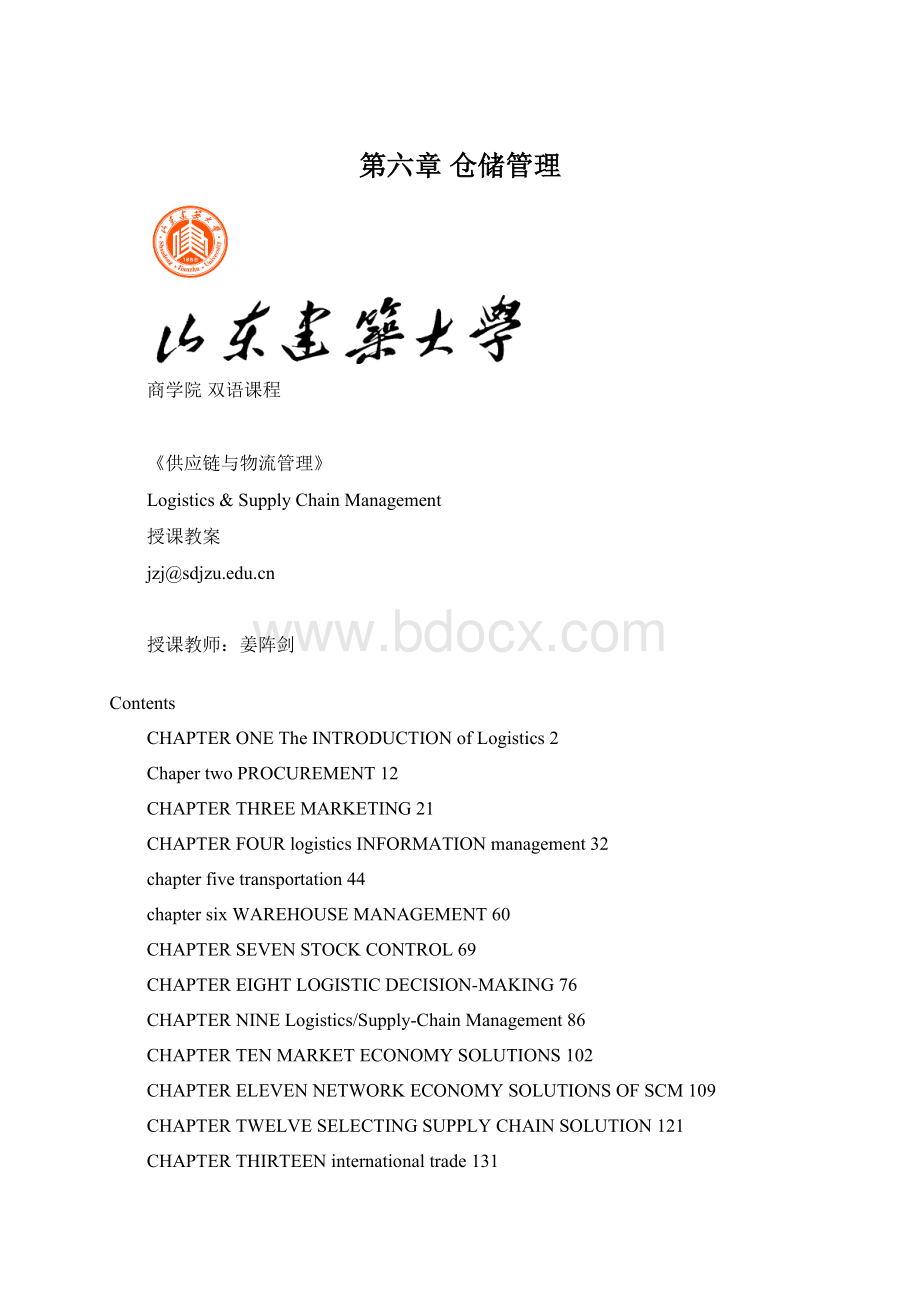第六章 仓储管理Word文档格式.docx
《第六章 仓储管理Word文档格式.docx》由会员分享,可在线阅读,更多相关《第六章 仓储管理Word文档格式.docx(10页珍藏版)》请在冰豆网上搜索。

jzj@
授课教师:
姜阵剑
Contents
CHAPTERONETheINTRODUCTIONofLogistics2
ChapertwoPROCUREMENT12
CHAPTERTHREEMARKETING21
CHAPTERFOURlogisticsINFORMATIONmanagement32
chapterfivetransportation44
chaptersixWAREHOUSEMANAGEMENT60
CHAPTERSEVENSTOCKCONTROL69
CHAPTEREIGHTLOGISTICDECISION-MAKING76
CHAPTERNINELogistics/Supply-ChainManagement86
CHAPTERTENMARKETECONOMYSOLUTIONS102
CHAPTERELEVENNETWORKECONOMYSOLUTIONSOFSCM109
CHAPTERTWELVESELECTINGSUPPLYCHAINSOLUTION121
CHAPTERTHIRTEENinternationaltrade131
CHAPTERFOURTEENLogisticsBestPractices138
CHAPTERFIFTEENBestPracticesCompaniesinSCMAction148
ChapterSix
WarehouseManagement
BasicRequirements:
掌握仓储和配送所涉及的关键因素,了解仓储成本构成和降低管理成本的主要途径,了解仓储和存储的基本过程。
MajorPoints:
仓储成本的构成。
DifficultPoints:
降低管理成本的主要途径。
Withcomingintothe21stcenturymanagementbegantoquestiontheneedforsomanywarehouses.Costswererising;
goodswerenotmovingfastenough,thedemandforquickerresponsetimesincreasedandconsumerdemandforgreatervarietyrose.Retailersfounditdifficulttosourceinsufficientquantityfromasinglesupplier.Thecostofsmallordersbecameexpensivetotransportationandthereforeitwasnecessarytohaveamorecentralisedwarehouseholdingagreatervarietyofinventoryforalargerdependentregionalarea.
Warehousesareviewedasatemporaryplacetostoreinventory,verymuchasairportsactasterminalhubsforpassengerswhoarethendistributedwidelyacrosstheworld,orcoachstationsdistributepassengersacrossthecountry.Atthischannelofdistributionthewarehousebecameasupportunitfornumerousretailoutlets.Progressivewarehousingandintegratedretailersdevelopedmechanicalandcomputerisedsystemstospeedupinformationflow,orderpickinganddelivery.Efficientwarehousingnowofferedamethodofreducingstorageandhandlingcostsandisnowseentobeanintegralpartofjustintime.
6.1PurposeOfWarehouse
Warehousesanddistributioncentreshaveaprimaryaim,whichistofacilitatethemovementofgoodsfromsupplierstocustomers,meetingdemandinatimelymanner.Inordertoachievethisefficientlytheymayhavetoholdstock,butthisisnottheirmainrole.Itmaybethatinventoryis
heldforcontingenciesortogivearapidcustomerserviceorinpreparationofanewproductlaunch.
Primarilywarehouses,andpassengerterminals,intheirpurestformshouldbeatrans-shipmentareawhereallgoodsreceivedaredispatchedaseffectivelyandefficientlyaspossible.Ifthiscouldbeachievedtherewouldbenocostinholdinggoods(orpeople)unnecessarily,buttheoverridingfactoristhatcompaniesmustmeetcustomerdemandandexpectations.Forthisreasonsomestockmustbeheldbutthisshouldbeminimisedsoastoavoidstockholdingcosts.Somevalidreasonsforholdingstockincludethefollowing:
Asabufferbetweentwoproductionprocesses;
Tocoverdemandduringsuppliers’leadtime;
Toenablesavingstobemadethroughbulkpurchasesordiscounts;
Tocopewithseasonalfluctuations;
Toprovideavarietyofproductinacentralisedlocation.
Warehousesarealsousedtobreakbulkintosmallerorders,tranship,consolidateandcompleteorderactivitiesforvariousdependentlocations.Logisticsmanagersshouldviewawarehouseasatemporaryplacetotranshipgoodstocustomers.Itmayinvolvesometemporarystoragebutessentiallyitisaplacetoundertakecustomerordercompletion,possiblysplittingbulkproductsandconsolidatingindividualitemsfromvariouslocations.
6.2WarehouseManagement
Increasingcustomerservicelevels,combinedwithpressurestoreduceinventoryandcosts,andtimecompression,meanthatwarehouseshavebeentransformedintodistributioncentres,existingprimarilytofacilitatethethroughputofgoodstotheenduser.Thisrelationshipbetweenwarehousinganddistributionmanagementisimportant.
Thewarehouseisavitallinkinthesupplychain,asittransportationsgoodstotheenduserandfromthemomentofdispatchmanagementhavelittleornocontroloveritsdeliverytothecustomer.Yetitissoimportantbecauseitisthefinalinterfacebetweensupplierandcustomerandifnothandledcorrectly,thecustomermaynotreorderwiththesupplier,orthecustomermayhavereasonforcomplaint,withtheincreasedlikelihoodofgoodsbeingreturnedCrucialissuesindistributionmayinvolvethefollowing:
1)Number,typeandlocationofwarehouses;
2)Typesofvehiclesusedfortruckinganddelivery;
3)LICTsystems,particularlyforordercapture,warehouseandstockmanagementandtransportationcontrol.
Inconsiderationoftheabove,decisionsmadebymanagementwilldictatewhethertheseactivitiesarecontrolledthroughownaccountoperations(wheretheresourcesaremanagedbythecompanyitself),orthroughthirdpartymanagement(whereservicesareprovidedbyanindependentspecialistoperatorenablingmanagementtoconcentrateoncoreactivitiestoreducecosts).
Undertheenvironmenttoday,therearemanycarrierswhowillmoveproductordelivergoodsandmanagementmustbeabletodecideatwhichpointdistributioncanbecontractedout.However,becauseoftheimportanceofthecustomer,itmaybeprudenttodeliverbyin-housetransportation,thereforemaintainingmanagementcontrolovertheinterfacebetweensupplierandcustomer.Morerecentlywiththeexplosionofe-tailingthedistributionfunctionhasbecomeoneofvitalimportancetobusinessprofitabilityascustomers’expectationsofreviewing,selectingandpayingforproductson-linehasincreasedtheexpectationofprocessspeed.
Warehousinganddistributionarecatchingupwithcustomerexpectations.Oneareawherethistrendhasbeenimportantistheuseofe-tailingbysupermarketchains.Customersareabletoordergoodson-lineandthesupermarketdeliversthegoodstothehome.Thereforethesupermarketisseentobealocalcommunitywarehouse,whichalsohasthecustomervisitingittoselectandpurchaseproducts.Thewholenewareaofthedistributionfunctionhasdevelopedonthebackofe-tailing,inthatcompaniesarenowdevelopingLICTprocessestoenableefficientdeliveryofproduct,the‘lastmile’fromthesuppliertothecustomerortothenearestpoint.
Withtheadoptionofelectronicdatainterchange(EDI),JITandLICT,managementhavetheflexibilitytoreacttomarketchange,andthesesystemswillapplyuptotheminuteinformationonstockavailability,locations,leadtimeanddispatch.Inthisenvironment,managementshouldconsidercarefullywhetherthereisanyneedtoholdstockortomaintainwarehousesatall.
Therearecompaniesthatsupplygoodsbutneverholdstock;
insteadtheypassoncustomerorderstotheirsupplierfordeliverydirecttothecustomer.Nowthate-tailinghasbecomecommon,somecompaniesaremerelyanorderinterface‘warehouse’whereordersfromtheInternetaredirectlypassedontosuppliersandproductsaredeliveredtocustomerswithouteverbeingdispatchedthroughthecompany’spremises.
6.3WarehouseCosts
Warehouserunningcostsvarywidelydependingonthenatureoftheiroperations.TheFreightTransportationAssociation(FTA)publishesguidelines(TheManager’sGuideto
DistributionCosts)inwhichitemphasisesthevariantsofcosts,butsuggeststhemaincostsareasfollows:
1)Staffing;
2)Buildingservices,maintenanceandfacilitiesmanagement;
3)Warehouseequipment,includingmaintenanceofmaterialshandlingequipment(MHE)andof
vehicles.
TheapplicationofLICTtowarehousingisoneofthewaysofreducingoverheadcostsandimprovingservicesinthatmanagersarenowawareoftherelevanceofinformationsuchasthefollowing:
1)Stockdemandandforecasting;
2)Stockpalletlocation,spaceutilization;
3)Stockvisibility;
4)Vehicleutilization/assettracking.
LICTmayreducestaffinglevels,andmayenabletheconsolidationofwarehouseswiththeresultantreductionofoverheads.Materialhandlingequipmentandorder-pickingsystems,althoughinitiallycostly,willhavelong-termcostbenefits.Throughoutthisthelogisticsmanagerneedstohaveanawarenessoftheoperatingoverheadsincludingstaffandequipmentandhowcarefulmanagementofthesecanhelptoreducethecostofwarehousing.
Manymanagersconcentratetheireffortsoncostsavingbyseekingtoreduceinventoryholdingwithoutcompromisingcustomerservice.Thiscanbeachievedinvariouswaysbutaglobalapproachencompassingallaspectsofthesupplychainwillalwaysgivebestresults.Thiswillinevitablyinvolvefosteringcloserrelationshipswithsuppliers(possiblyincludingpartnershipapproaches)andpossiblychangesinmanufacturingprocesses.TheuseofJITandEDIwillbringsavingsacrossthewholesupplychain,enablingproductionfororderratherthanproductionfor‘justincase’.
Securityisoftenlowdownonthelistofprioritiesthatalogisticsmanagerhastodealwith,butitisnonethelessimportant.Securityneedstobecommensuratewiththevalueofstockheldandtheperceivedrisks.Internalandexternalwarehousesecurityshouldbereviewed,possiblyusingaconsultant.
AnalyticalapproachestothistaskincludeSWOTanalysisandSTEPanalysisofinfluencesonthebusiness,whichshouldincludemethodstorestrictaccess,use,andbackupdatabasesorpowersupplies.SWOTanalysismeansanalysisofinternalStrengthsandWeaknesses,external
OpportunitiesandThreats.STEPanalysismeansanalysisofsocial,technological,economicandpolitical/legalfactorsinthebusinessenvironment.
Thismayincludeenablingonlyauthorisedpeoplewhoaretrainedtodealwithvaluableor